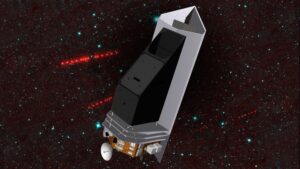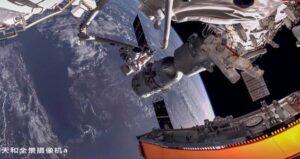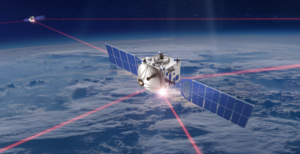NASA confirms NEO Surveyor for 2028 launch
Wednesday, 07 December 2022 11:52
NASA has approved for development a space telescope to search for near Earth objects as some members of Congress lobby the agency to move up the mission.
The post NASA confirms NEO Surveyor for 2028 launch appeared first on SpaceNews.
Britain set to launch its first space mission
Wednesday, 07 December 2022 11:49 A tentative date has been set for Britain's first space launch.
A launch window for Virgin Orbit's LauncherOne is scheduled to open Dec. 14, NASA's spaceflight editor Chris Bergin tweeted Tuesday.
Virgin Orbit's LauncherOne system has been used on five prior occasions but those missions departed from the Mojave Air and Space Port in California.
The upcoming LauncherOne mis
A tentative date has been set for Britain's first space launch.
A launch window for Virgin Orbit's LauncherOne is scheduled to open Dec. 14, NASA's spaceflight editor Chris Bergin tweeted Tuesday.
Virgin Orbit's LauncherOne system has been used on five prior occasions but those missions departed from the Mojave Air and Space Port in California.
The upcoming LauncherOne mis Momentus to Fly JINJUSat-1 for CONTEC
Wednesday, 07 December 2022 11:49 Momentus Inc. (NASDAQ: MNTS) has signed a contract with CONTEC Co. of the Republic of Korea to provide space transportation services for the JINJUSat-1 CubeSat.
JINJUSat-1 is spearheaded by three entities: Jinju City, Korea Testing Laboratory, and Gyeongsang National University. The satellite is targeted to launch aboard the SpaceX Transporter-9 mission no earlier than October 2023. Once i
Momentus Inc. (NASDAQ: MNTS) has signed a contract with CONTEC Co. of the Republic of Korea to provide space transportation services for the JINJUSat-1 CubeSat.
JINJUSat-1 is spearheaded by three entities: Jinju City, Korea Testing Laboratory, and Gyeongsang National University. The satellite is targeted to launch aboard the SpaceX Transporter-9 mission no earlier than October 2023. Once i Rocket Lab introduces dedicated national security subsidiary
Wednesday, 07 December 2022 11:49 Rocket Lab USA, Inc. (Nasdaq: RKLB) has created a U.S.-based wholly owned subsidiary to serve the defense and intelligence community. Rocket Lab National Security LLC (RLNS) will deliver reliable launch services and space systems capabilities to the U.S. government and its allies.
Since the Company's first launch of the Electron rocket in 2017, Rocket Lab has conducted multiple successful
Rocket Lab USA, Inc. (Nasdaq: RKLB) has created a U.S.-based wholly owned subsidiary to serve the defense and intelligence community. Rocket Lab National Security LLC (RLNS) will deliver reliable launch services and space systems capabilities to the U.S. government and its allies.
Since the Company's first launch of the Electron rocket in 2017, Rocket Lab has conducted multiple successful Elon Musk's SpaceX unveils Starshield satellite services for U.S. military
Wednesday, 07 December 2022 11:49 SpaceX is rolling out a new business called Starshield to support U.S. military applications, building upon the company's existing satellite system.
The latest Elon Musk endeavor expands on Starlink Internet satellite technology for national security uses, to include secure communications and space surveillance payloads, for its largest customer, the Pentagon.
"While Starlink is
SpaceX is rolling out a new business called Starshield to support U.S. military applications, building upon the company's existing satellite system.
The latest Elon Musk endeavor expands on Starlink Internet satellite technology for national security uses, to include secure communications and space surveillance payloads, for its largest customer, the Pentagon.
"While Starlink is Chinese scientists complete rice, Arabidopsis life-cycle experiments in space
Wednesday, 07 December 2022 11:49 Chinese scientists have completed the life-cycle growth experiments of rice and Arabidopsis in the Chinese space station and successfully obtained their seeds, said the Chinese Academy of Sciences (CAS) on Monday.
With the safe landing of the Shenzhou-14 spaceship's return capsule at the Dongfeng landing site Sunday night, the seeds of rice and Arabidopsis, which have undergone a 120-day l
Chinese scientists have completed the life-cycle growth experiments of rice and Arabidopsis in the Chinese space station and successfully obtained their seeds, said the Chinese Academy of Sciences (CAS) on Monday.
With the safe landing of the Shenzhou-14 spaceship's return capsule at the Dongfeng landing site Sunday night, the seeds of rice and Arabidopsis, which have undergone a 120-day l Mars megatsunami may have been caused by Chicxulub-like asteroid impact
Wednesday, 07 December 2022 11:49 A Martian megatsunami may have been caused by an asteroid collision similar to the Chicxulub impact - which contributed to the mass extinction of all non-avian dinosaurs on Earth 66 million years ago - in a shallow ocean region, according to a study published in Scientific Reports.
Previous research has proposed that an asteroid or comet impact within an ocean in the Martian northern lowla
A Martian megatsunami may have been caused by an asteroid collision similar to the Chicxulub impact - which contributed to the mass extinction of all non-avian dinosaurs on Earth 66 million years ago - in a shallow ocean region, according to a study published in Scientific Reports.
Previous research has proposed that an asteroid or comet impact within an ocean in the Martian northern lowla Measuring times in billionths of a billionth of a second
Wednesday, 07 December 2022 11:49 How fast do electrons inside a molecule move? Well, it is so fast that it takes them just few attoseconds (1 as = 10-18 s or one billionth of billionth of a second) to jump from one atom to another. Blink and you missed it - millions of billions of times. So measuring such ultrafast processes is a daunting task.
Scientists at the Australian Attosecond Science Facility and the Centre for Qu
How fast do electrons inside a molecule move? Well, it is so fast that it takes them just few attoseconds (1 as = 10-18 s or one billionth of billionth of a second) to jump from one atom to another. Blink and you missed it - millions of billions of times. So measuring such ultrafast processes is a daunting task.
Scientists at the Australian Attosecond Science Facility and the Centre for Qu Webb telescope promises new age of the stars
Wednesday, 07 December 2022 11:49 The James Webb Space Telescope lit up 2022 with dazzling images of the early universe after the Big Bang, heralding a new era of astronomy and untold revelations about the cosmos in years to come.
The most powerful observatory sent into space succeeds the Hubble telescope, which is still operating, and began transmitting its first cosmic images in July.
"It essentially behaves better th
The James Webb Space Telescope lit up 2022 with dazzling images of the early universe after the Big Bang, heralding a new era of astronomy and untold revelations about the cosmos in years to come.
The most powerful observatory sent into space succeeds the Hubble telescope, which is still operating, and began transmitting its first cosmic images in July.
"It essentially behaves better th NASA Researcher's AI 'Eye' could help robotic data-gathering
Wednesday, 07 December 2022 11:49 When it comes to making real-time decisions about unfamiliar data - say, choosing a path to hike up a mountain you've never scaled before - existing artificial intelligence and machine learning tech doesn't come close to measuring up to human skill. That's why NASA scientist John Moisan is developing an AI "eye."
Moisan, an oceanographer at NASA's Wallops Flight Facility near Chincoteague,
When it comes to making real-time decisions about unfamiliar data - say, choosing a path to hike up a mountain you've never scaled before - existing artificial intelligence and machine learning tech doesn't come close to measuring up to human skill. That's why NASA scientist John Moisan is developing an AI "eye."
Moisan, an oceanographer at NASA's Wallops Flight Facility near Chincoteague, China's two meteorological satellites put into operation
Wednesday, 07 December 2022 11:49 Two meteorological satellites, along with their ground application systems, have officially started operation, said the China Meteorological Administration on Thursday.
The trial operation of the two satellites, Fengyun-3E (FY-3E) and Fengyun-4B (FY-4B), began in June this year. They will provide observation data and application services to global users.
The FY-3E, launched on July 5
Two meteorological satellites, along with their ground application systems, have officially started operation, said the China Meteorological Administration on Thursday.
The trial operation of the two satellites, Fengyun-3E (FY-3E) and Fengyun-4B (FY-4B), began in June this year. They will provide observation data and application services to global users.
The FY-3E, launched on July 5 Kilometer-scale modeling better reflects the relationship between land and precipitation
Wednesday, 07 December 2022 11:49 The technique referred to as "dynamical downscaling", which involves the use of regional climate models to dynamically infer the effects of large-scale climate processes at local scales, has proved to be an effective way to simulate precipitation at high resolution. Moreover, with advancements in supercomputing capabilities, dynamical downscaling is now progressing to the kilometer scale.
The technique referred to as "dynamical downscaling", which involves the use of regional climate models to dynamically infer the effects of large-scale climate processes at local scales, has proved to be an effective way to simulate precipitation at high resolution. Moreover, with advancements in supercomputing capabilities, dynamical downscaling is now progressing to the kilometer scale. ESA plasma sampler headed to the Moon and ISS
Wednesday, 07 December 2022 11:46
An innovative ESA-backed instrument to sample the space weather environment in-situ is set to join the International Space Station. Norway’s multi-Needle Langmuir Probe, m-NLP, due to be fitted to the European-made Bartolomeo platform on the ISS, a ‘front porch’ open to space, will map the ionospheric plasma surrounding the Station in unprecedented high resolution, performing almost 10 000 measurements per second continuously along its orbit.
China is considering expanding its Tiangong space station
Wednesday, 07 December 2022 11:26
China is already considering adding modules to its recently-completed Tiangong space station complex, according to a senior space official.
Mynaric, Redwire, BigBear.ai partner for DARPA’s laser communications program
Tuesday, 06 December 2022 23:35
Mynaric selected a cybersecurity tool from Redwire and BigBear.ai for an inter-satellite laser communications terminal being developed for DARPA
The post Mynaric, Redwire, BigBear.ai partner for DARPA’s laser communications program appeared first on SpaceNews.
